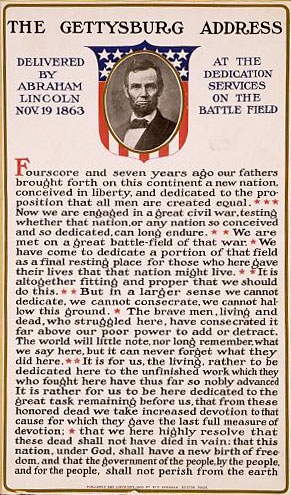
Source: Lincoln Memorial (Lincoln contrasty), George F. Maxwell, Wikimedia
Parallel structure, or parallelism, is a type of repetition. It is a pattern of words in which two or more elements of a sentence or paragraph have the same importance. Parallelism is useful because it
- helps a reader follow a text,
- shows how ideas are related,
- shows how ideas are different, and
- makes the writing memorable.
Guess what? The bulleted list above is parallel. Each bullet begins with a present tense verb. However, verbs are not the only parts of a sentence that can be made parallel. Subjects, objects, nouns, adverbs, and adjective phrases can also be parallel.

Source: Gettysburg Address (poster),
M.T. Sheahan, Library of Congress
To see an example of parallelism, read this passage from the Gettysburg Address.
It is rather for us to be here dedicated to the great task remaining before us—that from these honored dead we take increased devotion to that cause for which they gave the last full measure of devotion—that we here highly resolve that these dead shall not have died in vain—that this nation, under God, shall have a new birth of freedom—and that government of the people, by the people, for the people, shall not perish from the earth.
Look at the blue highlighted section: “of the people, by the people, for the people.” This use of parallelism makes the sentence memorable. When you read this sentence, if you did not remember that Lincoln said it, you probably remembered that you had head it somewhere.
Now, look at the pink highlighted words. Directly or closely following each “that” is a noun or pronoun: “the honored dead,” “we,” “this nation,” and “government.” Although the words following “that” are not strictly parallel with one another, the repetition of this word followed directly or closely by a noun or pronoun gives Lincoln’s speech a rhythm that builds up to the famous “of the people, by the people, for the people” quotation.
In the activity below, click on the sentence in each pair that correctly shows a parallel structure.

1.
2.
3.
4.
5.

Read the passage below from The Fight by Norman Mailer, which details a boxing match between Muhammad Ali and George Foreman. As you read, click on each example of parallel structure.

Source: StangoAli, John Stango, Wikimedia
 What effect does Mailer’s use of parallel structure have on the reader? When you are finished, check your understanding to see some possible responses.
What effect does Mailer’s use of parallel structure have on the reader? When you are finished, check your understanding to see some possible responses. Sample Responses:
Mailer’s use of parallel structure creates a sense of rhythm that mimics the rhythm of a boxing match. While he uses some phrases that are perfectly grammatically parallel (some to the head, some to the body), He also breaks the rules a bit (one collided with Ali’s floating ribs, brutal punches, jarring and imprecise as a collision at slow speed in a truck. . .) to more accurately depict the varying rhythms of a real boxing match. This varying rhythm engages the reader in the story and helps him or her imagine what it was like to watch Foreman and Ali fight.